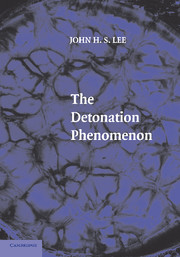Book contents
- Frontmatter
- Contents
- Preface
- 1 INTRODUCTION
- 2 GASDYNAMIC THEORY OF DETONATIONS AND DEFLAGRATIONS
- 3 DYNAMICS OF DETONATION PRODUCTS
- 4 LAMINAR STRUCTURE OF DETONATIONS
- 5 UNSTABLE DETONATIONS: NUMERICAL DESCRIPTION
- 6 UNSTABLE DETONATIONS: EXPERIMENTAL OBSERVATIONS
- 7 INFLUENCE OF BOUNDARY CONDITIONS
- 8 DEFLAGRATION-TO-DETONATION TRANSITION
- 9 DIRECT INITIATION OF DETONATIONS
- Epilogue
- Index
7 - INFLUENCE OF BOUNDARY CONDITIONS
Published online by Cambridge University Press: 06 July 2010
- Frontmatter
- Contents
- Preface
- 1 INTRODUCTION
- 2 GASDYNAMIC THEORY OF DETONATIONS AND DEFLAGRATIONS
- 3 DYNAMICS OF DETONATION PRODUCTS
- 4 LAMINAR STRUCTURE OF DETONATIONS
- 5 UNSTABLE DETONATIONS: NUMERICAL DESCRIPTION
- 6 UNSTABLE DETONATIONS: EXPERIMENTAL OBSERVATIONS
- 7 INFLUENCE OF BOUNDARY CONDITIONS
- 8 DEFLAGRATION-TO-DETONATION TRANSITION
- 9 DIRECT INITIATION OF DETONATIONS
- Epilogue
- Index
Summary
INTRODUCTION
The detonation velocity from the Chapman–Jouguet (CJ) theory is independent of initial and boundary conditions and depends only on the thermodynamic properties of the explosive mixture. Experimentally, however, it is found that initial and boundary conditions can have strong influences on the propagation of the detonation wave. It is the finite thickness of the reaction zone that renders the detonation vulnerable to boundary effects. Thus, the influence of the boundary can only enter into a theory that considers a finite reaction-zone thickness. In the original paper by Zeldovich (1940) on the detonation structure, he already attempted to include the effect of heat and momentum losses on the propagation of the detonation wave. However, in the one-dimensional model of Zeldovich, the two-dimensional effect of losses at the boundary cannot be treated properly. It was Fay (1959) who later modeled boundary layer effects more accurately as a divergence of the flow in the reaction zone behind the shock front, resulting in a curved detonation front. Thus, heat and momentum losses become similar to curvature effects due to the lateral expansion of the detonation products in a two- or three-dimensional detonation. However, for small curvature this can be modeled within the framework of a quasi- one-dimensional theory.
- Type
- Chapter
- Information
- The Detonation Phenomenon , pp. 204 - 249Publisher: Cambridge University PressPrint publication year: 2008



